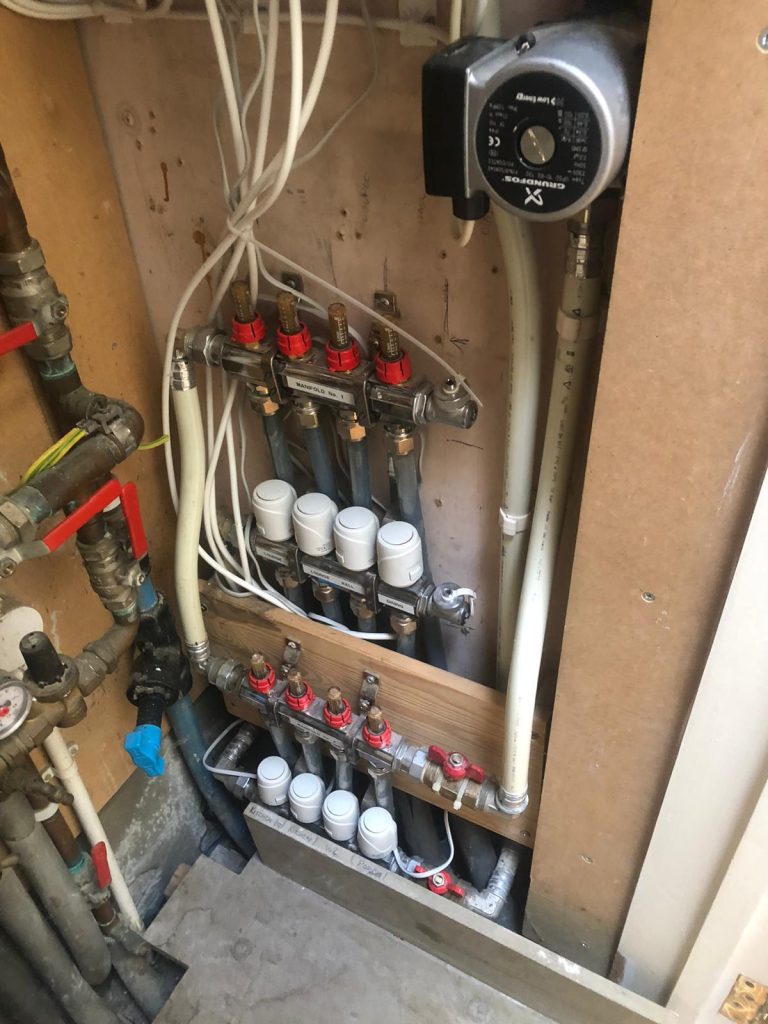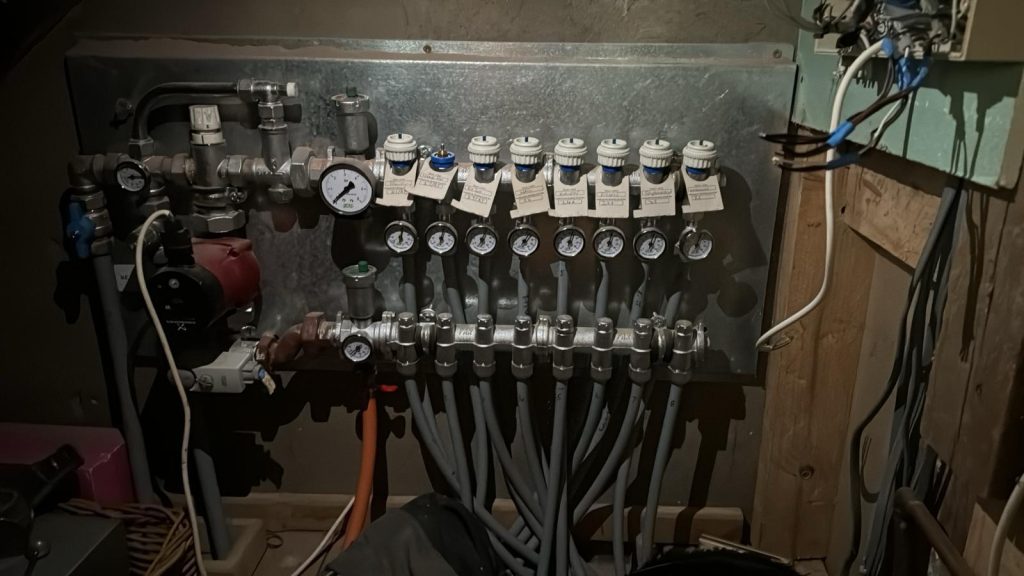Underfloor heating has become a desirable feature in homes throughout Edinburgh, providing discreet, even warmth and freeing up wall space otherwise used by radiators. In older properties—such as Victorian villas, Georgian townhouses, and Edwardian flats—underfloor heating can offer modern comfort while preserving the period aesthetic.
However, integrating underfloor heating into these heritage buildings is not without its challenges. Edinburgh’s older housing stock presents a range of construction quirks and limitations that can contribute to system faults over time. Whether you’re dealing with intermittent heating, cold spots, or complete system failure, it’s essential to understand the common causes of underfloor heating issues in period homes.
In this article, we explore the top causes of underfloor heating failure in older Edinburgh properties, and offer advice on how to prevent or resolve them effectively.

1. Poor or Inappropriate Installation
A significant number of underfloor heating failures in Edinburgh’s older homes can be traced back to poor installation. Retrofitting underfloor heating in properties built 100 years ago or more requires specialist knowledge and careful planning. Unfortunately, not all installers account for the specific challenges of heritage buildings.
Common installation issues include:
- Poorly designed pipe layouts
- Incorrect spacing of heating loops
- Inadequate screed depth or poor-quality insulation
- Faulty electrical connections (in electric systems)
- Pipes placed too close to floor surfaces or subfloors
In buildings with suspended timber floors—a common feature in tenement flats—installing wet UFH between joists without proper support or insulation can result in heat loss and structural damage.
Solution: Always use experienced installers familiar with Edinburgh’s housing stock. Ensure that a detailed site survey and system design are completed before installation begins.
2. Insufficient Insulation
Insulation is key to efficient underfloor heating. Many older homes in Edinburgh lack sufficient insulation under floors, within walls, or above ceilings. Installing UFH without addressing these gaps often leads to rapid heat loss.
Inadequate insulation beneath the heating system can cause:
- Heat being absorbed into subfloors or ground below
- Increased energy bills due to inefficiency
- Cooler floor temperatures despite high thermostat settings
- Long heat-up times or inconsistent room temperatures
For ground-level or basement floors, the absence of insulation can also introduce damp issues, compounding the problem.
Solution: During installation or repair, ensure that high-performance insulation is laid below the UFH system. For suspended timber floors, insulation should be fitted snugly between joists with airtight sealing.
3. Airlocks and Circulation Problems in Wet Systems
Wet underfloor heating systems rely on the smooth circulation of water through a network of pipes connected to a manifold. In older properties, particularly those with awkward plumbing layouts, airlocks and restricted flow are common problems.
Symptoms of circulation issues include:
- Cold zones or uneven heating across a room
- Pump noise or gurgling in the system
- Reduced pressure at the manifold
- Complete failure in one or more heating zones
Airlocks often result from improper commissioning or after system drainage during renovation works.
Solution: Bleed the system using the manifold or bleed valves to remove trapped air. Ensure all circuits are properly balanced to distribute heat evenly. If problems persist, a full system flush and pressure test may be required.
4. Electrical Component Failures in Dry Systems
Electric underfloor heating systems are commonly used in smaller spaces, such as bathrooms or kitchens, due to their ease of installation. However, in older buildings with outdated electrical infrastructure, faults can occur.
Common failures include:
- Broken or damaged heating mats or cables
- Thermostat or floor sensor malfunctions
- Power supply issues due to overloaded circuits
- Short circuits caused by moisture ingress
Electric UFH is especially vulnerable if flooring is lifted or replaced, or if fixings are drilled into heated zones.
Solution: Use a certified electrician to test the system with an ohmmeter or thermal imaging. Thermostat upgrades and improved cable protection may be required. Avoid nailing or screwing into heated floors without accurate floor plans.
5. Incompatible Floor Finishes
Many of Edinburgh’s period properties feature beautiful original flooring—such as stone flags, solid hardwood, or decorative tiles. While these materials can be compatible with underfloor heating, the wrong combination of materials and adhesives can reduce performance or cause system damage.
Examples of incompatibility include:
- Thick carpets or underlays blocking heat transfer
- Timber floors expanding and warping due to thermal cycles
- Tiles cracking due to uneven heating or poor adhesive
- Incompatible finishes preventing correct sensor readings
Solution: Choose floor coverings certified for UFH compatibility. Use flexible adhesives and grouts for tile installations, and opt for engineered wood instead of solid timber. Always consider the floor’s total tog rating to ensure efficient heat output.
6. Leaks or Pipe Damage in Water-Based Systems
Although rare, leaks in wet underfloor heating systems can be serious—especially in older homes where pipe runs are hidden under original floors or hard-to-access spaces.
Causes of leaks include:
- Poorly installed or crimped joints
- Corrosion or movement in fittings
- Punctures from construction work
- Excessive pressure or faulty expansion vessels
Leaks may result in pressure loss, cold areas, and damage to structural elements. In Edinburgh’s tenements, they may even affect neighbouring flats below.
Solution: Monitor system pressure regularly. Use a pressure gauge and isolation testing to locate leaks. If necessary, hire a UFH specialist with thermal imaging or tracer gas equipment to detect hidden damage.
7. Outdated Controls or Zoning Issues
Older UFH systems often rely on basic thermostats or single-zone controls, which are inadequate for larger or multi-room layouts. This leads to:
- Overheating in some areas and underheating in others
- Constant on/off cycling of boilers or pumps
- Increased energy consumption and poor comfort levels
This is especially problematic in Georgian or Victorian townhouses that have been subdivided or extended without updating the heating control logic.
Solution: Upgrade to smart thermostats and zone valves. Zoning allows each room or floor to be heated independently, improving comfort and energy efficiency. Many modern control systems can be retrofitted to existing UFH setups.
8. Sludge and Limescale Build-Up
In older properties with central heating systems predating the underfloor heating installation, pipework and boilers may already be subject to sludge and limescale accumulation. These materials can migrate into the UFH system, causing:
- Reduced water flow
- Blockages in narrow pipework
- Pump strain and eventual failure
- Cold patches due to restricted circuits
Hard water areas, such as parts of Edinburgh, are particularly prone to this issue.
Solution: Power flush the system and install magnetic filters to prevent future sludge build-up. Consider fitting a scale reducer if you live in a hard water area. Regular servicing is essential to maintain system health.
9. Structural Movement and Settlement
Edinburgh’s older buildings are often affected by settlement or subtle movement over time. This can cause cracking, shifting of floor levels, or misalignment of components. UFH systems, especially electric ones or rigid manifolds, may suffer as a result.
For example:
- Pipes can be pulled or twisted, reducing flow
- Connections may loosen or leak
- Flooring may compress or separate from heat sources
Solution: Choose flexible pipe materials and allow for expansion joints in screed installations. Regular inspection and tightening of fittings can also prevent long-term issues.
10. Lack of Regular Maintenance
While underfloor heating is often marketed as “low maintenance”, it still requires periodic inspection and servicing—especially in older homes. Common maintenance oversights include:
- Ignoring pressure drops in the system
- Failing to clean filters or bleed valves
- Outdated or uncalibrated thermostats
- Neglecting minor faults that worsen over time
In many cases, early intervention can prevent a full system failure.
Solution: Schedule annual servicing with a qualified UFH technician. Maintain documentation of your system layout and zones to help diagnose issues quickly in the future.

How to Prevent Underfloor Heating Failure in Edinburgh Period Homes
Preventing UFH failure in older Edinburgh properties begins with careful design, professional installation, and regular maintenance. Here are some key tips:
- Use experienced installers who understand heritage buildings
- Insulate thoroughly, especially beneath floors
- Choose compatible flooring and adhesives
- Upgrade controls and zone valves for better performance
- Service the system annually to catch problems early
- Keep installation records and floor plans for future reference
If you’re planning a retrofit, consult both a heating engineer and a conservation expert (if your property is listed) to ensure compliance and protection of original features.
Conclusion
Underfloor heating can bring modern comfort to even the oldest Edinburgh homes—if it’s installed and maintained correctly. While period properties present unique challenges, many of the most common causes of UFH failure can be prevented with expert planning, appropriate materials, and regular system care.
Whether you’re troubleshooting an underperforming system or planning a retrofit for your Georgian tenement or Victorian townhouse, make sure you work with professionals who understand both the technology and the building’s heritage.
By doing so, you’ll enjoy reliable, energy-efficient warmth for years to come—without compromising the character of your home.
